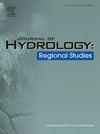墨西哥和美国之间有效的跨界含水层区域:全边界方法
IF 4.7
2区 地球科学
Q1 WATER RESOURCES
引用次数: 0
摘要
研究区域本研究位于美国和墨西哥边境地区。研究重点本研究旨在确定美墨边境共有的水文地质单元中,由于边境两侧地下水过度开采而可能处于脆弱状态的区域。有效跨界含水层区域(ETAA)方法试图代表含水层地质边界内地下水生产的有效地理区域,以便在更细化的地方范围内优先考虑脆弱区域。为确定 ETAA,本研究使用井密度井深数据来描绘深度等值线,以替代跨界地下水流的潜在影响。这种方法有助于整合利益相关者的观点和覆盖 ETAA 的社区的具体需求。结果显示了整个美墨边境地区的 ETAA 位置和延伸范围,确定了最脆弱和高度依赖地下水的地区。本文章由计算机程序翻译,如有差异,请以英文原文为准。
Effective transboundary aquifer areas between Mexico and the United States: A border-wide approach
Study Region
This research is situated in the U.S-Mexico border region. It encompasses the geographical extension of the 28 transboundary aquifers located across the ten border states between the two countries.
Study Focus
This study aims to identify regions within the hydrogeological units shared across the U.S.-Mexico border that could be in a vulnerable condition due to groundwater overexploitation on either side of the border. The Effective Transboundary Aquifer Area (ETAA) approach attempts to represent those effective geographical areas of groundwater production within the geological boundaries of the aquifer, to prioritize vulnerable areas at a more refined and local scale. To identify ETAAs, this study uses well density well depth data to portray depth contours as a proxy for potential impacts of groundwater flows at transboundary level.
New Hydrological Insights
For planning and management purposes at binational scale and considering the constraints on data and research on transboundary aquifers, the ETAAs provide a more feasible and useful approach to assess the conditions of a shared resource at a more “localized” scale. This approach facilitates the integration of stakeholders’ perspectives and specific needs of the communities that overlay the ETAA. Results show the location and extension of the ETAAs across the complete U.S.-Mexico border identifying the most vulnerable and highly groundwater-dependent regions.
求助全文
通过发布文献求助,成功后即可免费获取论文全文。
去求助
来源期刊

Journal of Hydrology-Regional Studies
Earth and Planetary Sciences-Earth and Planetary Sciences (miscellaneous)
CiteScore
6.70
自引率
8.50%
发文量
284
审稿时长
60 days
期刊介绍:
Journal of Hydrology: Regional Studies publishes original research papers enhancing the science of hydrology and aiming at region-specific problems, past and future conditions, analysis, review and solutions. The journal particularly welcomes research papers that deliver new insights into region-specific hydrological processes and responses to changing conditions, as well as contributions that incorporate interdisciplinarity and translational science.
 求助内容:
求助内容: 应助结果提醒方式:
应助结果提醒方式:


